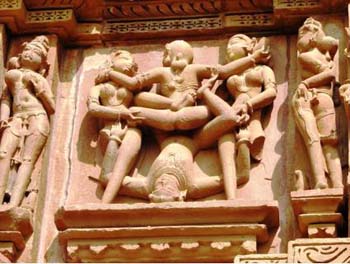By Margaret Deefholts
It is a gloriously sunny, but mild January morning and the temples are silhouetted against a deep blue sky. Tourists cluster around their guides; some of them gaze bemused at the explicit sexual positions depicted on the walls, others snicker and exchange sly winks. My own guide, Jagdip, is an earnest young man and he has his spiel down pat.
“Originally about 85 temples were built here between the 9th and 14th century, but today only 25 survive.” He gestures across the site’s manicured lawns and bordering flower beds filled with orange marigolds and scarlet cannas. “We are in the Western group and we will visit the rest in the Eastern group a little later.”
He turns back to the temple façade before us. It is adorned with divine and semi-divine figures-celestial dancers, heavenly beauties, musicians, cherubs and above all, several amorous couples. In one frieze, a voluptuous woman, her hip out-thrust, looks flirtatiously up at her partner; he looks adoringly down at her while cupping one of her full, rounded breasts in his palm. Another tableaux portrays a ménage à trois, and along the base of another temple an elaborately carved band runs around the parameter depicting couplings in every conceivable position.
Standing in front of the Kandriaya Mahadeva temple I goggle at a pose so contorted that it prompts me to remark, “How could they possibly be enjoying this?” The pose in question shows a male standing on his head while straddled by a female, the pair of them in coitus, the female supported by two heavenly maidens.
Jagdip clears his throat. “Yes…well this is a Yoga pose, and is possibly Tantric in origin.
Tantric rituals are often linked to dark occult practices, but it is also a philosophy that centres on sexual energy as being part of the cosmic circle of re-birth arising from death and destruction. The arousal of sensual passion also brings with it a karmic awakening, and a god such as Shiva, the Destroyer and the malevolent goddess Kali, are yoked to pure energy (“shakti”) a force that fuels the universe and all things within it. Temples throughout the country display Shiva-Lingams-an erect “lingam” (phallus) cradled in the “yoni” (vagina), symbolizing the mystical power of creativity.
Sexuality and spirituality went hand in hand even before the temples in Khajuraho took shape. Back in the 6th century AD a scholar, Vatsyayana, who was (get this!) an ascetic and a yogi, authored the “Kama Sutra” a detailed and explicit treatise on the art of love-making. This instruction manual not only lists sixty-four sexual positions (many of them requiring the agility of a gymnast and the flexibility of a contortionist), but also gravely discusses a wide range of philosophical concepts such as Dharma, (virtuous living), Artha, (material prosperity) Kama (aesthetic and erotic pleasure) and Moksha (liberation from the cycle of rebirth).
Indian erotic paintings mirror the sculptures that adorn Khajuraho. Like the amorous couples on the temple facades, paintings depict curvaceous women and well endowed men gazing tenderly into each others’ eyes while engaged in sexual couplings. Some paintings are whimsical-a couple makes ardent love in a howdah perched on an elephant, another couple is likewise engaged while riding a camel!
About the same time as the Kama Sutra was written, professional temple dancers known as Devadasis were to be found in temples throughout India. Young virgins, dedicated to the temple deity, were trained as erotic dancers; their role was also to pleasure patrons in the temple precincts using techniques described in the Kama Sutra. Temple prostitution was prohibited in 1988, but Jagdip wobbles his head ruefully as he admits, “here and there this practice still exists.”
Today’s India in fact, seethes with repressed sexuality. Society prohibits sexual dalliances and arranged marriages are the norm, so many couples have never set eyes on one another until the day of their wedding. They come as virgins to the nuptial bed. Carnal desires hide in the shadows. But for the inhibited or shy there is a whole world of sexual voyeurism – Bollywood movies! In darkened theatres, audiences salivate over seductive, scantily clad heroines as they sing, dance and flirt.
But the world of movies in India go a step further. They spin dramatic stories of human passion and divine adoration. They speak to universal emotions; they transcend time. So too do the erotic temples of Khajuraho.
If You Go:
Getting There: Khajuraho is accessible by air from Delhi
Where to Stay: http://www.khajuraho.org.uk/hotels/index.html
General Information: http://www.khajuraho.org.uk/index.html
About the author:
Margaret Deefholts is a travel writer as well as the editor of the Travel Writers’ Tales article syndicate and website.
